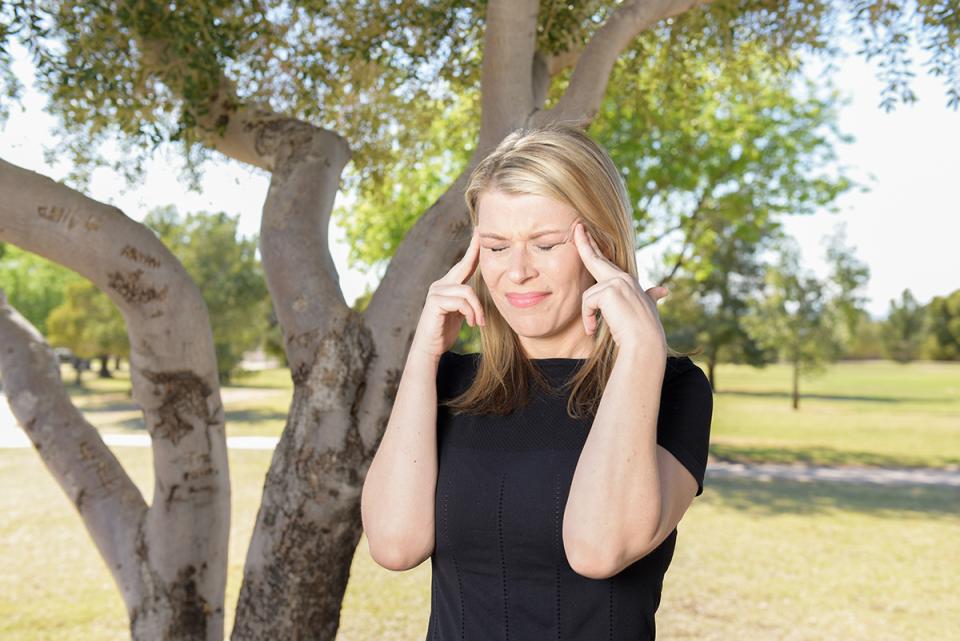Headaches and migraines
While nearly everyone has experienced a headache at least once, you may be someone who suffers from more severe and/or frequent versions of headaches. If you do, you'll be able to find compassionate care from HonorHealth.
Primary headaches occur due to the headache itself — not another condition. The three types of primary headaches are tension, cluster and migraine headaches.
Tension headaches
The most common type of headache is the tension headache. You'll feel squeezing and/or dull pressure on both sides of the head. Your symptoms can be mild to severe, but activity does not make the headache any worse.
You can experience a tension headache as a chronic condition (15-plus days a month) or episodic (fewer than 15 days a month).
Although doctors aren't sure what causes tension headaches, stress is believed to be a factor.
Treatment options include pain relievers or hot showers and compresses on your neck. For chronic headaches, your doctor may prescribe medication.
Cluster headache
A cluster headache refers to the centralized location of a headache, not a group of headaches that happen around the same time.
Pain from a cluster headache is typically focused on one side of the face, around and behind one eye. This pain can be severe, so much so that many people feel the need to pace to relieve the pain. You may also experience a drooping eyelid, watering from your eye or a runny nose on the same side of the face you're experiencing the headache.
Cluster headaches are rare, affecting one in 1,000 people. Cluster headaches are more common in men and in smokers.
Over-the-counter pain relievers typically do not stop a cluster headache.
Your doctor will work with you to help you create a treatment plan, which may include:
- Preventive medication to help you avoid having a cluster headache
- Lifestyle changes to prevent triggers of cluster headaches
Migraines
Migraine is a neurological disease defined by periodic intense head pain that can be accompanied by a number of other symptoms, including nausea and extreme sensitivity to light. These additional symptoms make migraine headaches very different from non-migraine headaches. A typical non-migraine headache occurs on both sides of the head; a migraine headache often occurs on only one side.
What are the phases of migraine headaches?
Phase 1, prodrome: This phase is sometimes called preheadache or premonitory phase. Its symptoms include aphasia, or difficulty speaking; excessive yawning; tiredness; difficulty concentrating; constipation or diarrhea; increased urination; mood changes; and neck pain. This phase can last for up to two days or as little as two hours before the next phase begins.
Phase 2, aura: Only about 25% of migraine sufferers experience this phase. Symptoms can include visual disturbances; hypersensitivity to touch, difficulty speaking, hearing imaginary sounds, loss of hearing, confusion, dizziness, and numbness or tingling.
Phase 3, headache: This is most often the worst phase of migraines. Symptoms include a one-sided headache that can pulse or throb. It's made worse by physical activity and lasts up to 72 hours. The pain can shift from one side to the other, become noticeable on both sides or start out on both sides and stay that way throughout the episode.
Additional symptoms include:
- Pain around the eyes, sinuses and the jaw
- Nasal congestion and runny nose
- Nausea and vomiting
- Neck pain
- Heightened sensitivity to odors
- Heightened sensitivity to sound
- Heightened sensitivity to light
- Vision changes, including cloudy vision
- Dehydration
- Confusion
- Weakness
Phase 4, postdrome: After the headache phase passes, many people experience fatigue, moodiness and reduced ability to concentrate.
How is migraine headache diagnosed?
Your HonorHealth neurologist will:
- Make a diagnosis based on the symptoms you're experiencing. If you have experienced the aura phase that causes spots, lights or blurry lines to appear in your line of sight and any other classic symptoms of migraine, it may be enough for a diagnosis. If you don't experience the aura phase, then a diagnosis might require at least two of the following symptoms during the headache phase: nausea, vomiting, sensitivity to light, sensitivity to sound or sensitivity to smell.
- Consider ordering a brain scan to confirm the diagnosis
Causes and risk factors for migraine headache
These include:
- Family history
- Change in routine
- Too little or too much sleep
- Excessive consumption of caffeine
- Hormonal changes in women
- High altitude, weather changes, high humidity
- Loud noises
- Exposure to flickering lights
Treatment options for migraine headaches
Your treatment could include:
- Triptans, prescription medications that reduce inflammation and constrict blood vessels
- DHE 45, a prescription injectable medication that causes blood vessels in the brain to narrow
- Ergotamine, a medication derived from a type of fungus called ergot that eases symptoms by narrowing blood vessels in the brain
- Antidepressants
- Over-the-counter pain relievers
- Natural remedies, such as vitamins, minerals and herbal treatments
- Mind-body medicine, including yoga, acupuncture and meditation
